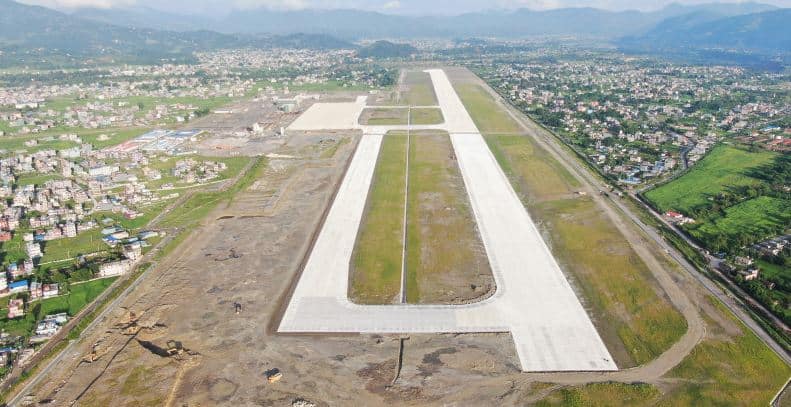Pokhara and Bhairahawa Airports' Underutilized Potential: CAAN's Strategic Failure

Nepal is home to three strategically located international airports: Tribhuvan International Airport in Kathmandu, Gautam Buddha International Airport in Bhairahawa, and Pokhara International Airport. The country is renowned for its stunning landscapes and rich cultural heritage. The main hub is Tribhuvan International Airport in Kathmandu, but despite major Chinese loan investment, the airports in Bhairahawa and Pokhara have not yet seen a significant number of international flights that correspond with their potential.
Buddha Jayanti celebrations coincided with the official opening of Gautam Buddha International Airport in Bhairahawa in May 2022, highlighting the airport's symbolic and functional significance. Pokhara International Airport, which is located in the heart of the charming tourist destination of Pokhara, followed suit and opened for business on January 1, 2023. These airports were envisioned not only to alleviate congestion at Tribhuvan International Airport but also to catalyze Nepal's tourism industry.However, despite these aspirations and substantial investments, the Bhairahawa and Pokhara airports have struggled to achieve their anticipated impact. Strategic interventions are necessary to address their underutilization in order to fully realize their potential and make sure that they serve as essential entry points for foreign visitors interested in discovering Nepal's natural and cultural treasures.
Strategies for Regular Scheduled Flights:
Strict Laws
Through regulatory procedures, the Civil Aviation Authority of Nepal (CAAN) can require airlines to conduct flights from these airports. Airlines that operate multiple daily flights from Kathmandu may be mandated to fly a minimum of two weekly flights from Bhairahawa or Pokhara. Furthermore, permission for airlines requesting extra slots in Kathmandu should only be given if those airlines also operate out of the other two airports. By enforcing a more equitable distribution of air traffic, this strategy would encourage the utilization of the more recent airports.
Operational Incentives
In order to successfully encourage airlines to fly out of the airports in Pokhara and Bhairahawa, CAAN ought to provide advantages that go beyond the surrounding area. CAAN can expand the 50% discounts to the airlines' ongoing operations in Kathmandu in addition to the ground handling services (GHS), landing parking, and navigation fees for operations at these airports. The airlines would need to promise to run at least two flights out of Kathmandu airports in order for this extension to be granted. In order to promote a balanced distribution of air traffic throughout Nepal, such a policy would encourage airlines to build a presence in Pokhara and Bhairahawa while continuing to operate out of Kathmandu.
Establishing Labor Offices and Medical Centers
In order to streamline operations and draw attraction of more flights, Bhairahawa and Pokhara should promptly open labor offices for the purpose of processing work permits and medical centers for the purpose of granting medical clearances. This project would increase airport usage and provide workers flying overseas with greater convenience.
Impact on Tour Itineraries
Regular flights to Pokhara and Bhairahawa would greatly improve tour itineraries throughout Nepal. The range of destinations included in tour packages is currently restricted due to poor road conditions. On the other hand, more extensive and less taxing travel arrangements would be possible with direct flights to these airports. For instance, a leisure traveler from America who arrives directly in Pokhara could take advantage of a comprehensive and varied itinerary:
Day 1: Arrive at Pokhara International Airport and Transfers to your Hotel in Pokhara.
Day 2: Full Day Tour of Beni Bazar, Baglung Kalika, Kushma Bazar including Bungy Jump and River Rafting
Day 3: Full Day Pokhara City Sightseeing and Early Morning Sunrise from Sarangkot or Peace Stupa
Day 4: Drive to Chitwan and Evening Enjoy the Tharu Cultural Shows.
Day 5: Jungle Safari at Chitwan National Park
Day 6: Drive to Kathmandu with stopover for river rafting or at Manakamana en route.
Day 7: Full Day Tour of Kathmandu, stopping at Bouddha, Swoyambhu, Durbar Square, and Thamel for shopping
Day 8: Full Day Tour of Patan, Nagarkot, and Bhaktapur
Day 9: Fly Back to America from Tribhuvan International Airport Kathmandu.
For religious tourism, travelers could proceed to Lumbini from Pokhara, following a similar itinerary. Such itineraries would extend tourists' stays in Nepal and provide a more enjoyable experience by reducing travel fatigue. These are just an example and Tour operators will design longer itineraries to keep tourists in Nepal for longer time.
Why the Strategy Isn't Used Till Now?
Despite the clear benefits, several factors have contributed to the delayed implementation of these strategies:
Unstable Government: Nepal's political environment is characterized by a high rate of leadership turnover, which results in unpredictable changes to policies and agendas. As every new administration amends or reverses prior decisions, long-term initiatives frequently encounter delays and disruptions. It is difficult to implement initiatives that take time to show results because of this volatility. Because policies can change with every new government, this unpredictability presents challenges for long-term investors such as airlines, tour operators, and travel agencies.
Lack of Expertise
The tourism sector leaders including bureaucrats and political leaders requires specialized knowledge in global travel trends, marketing, and infrastructure management. Unfortunately, there is often a gap in expertise among officials tasked with tourism in Nepal. This deficiency results in poorly formulated policies that fail to address the real needs of the industry. Effective tourism development necessitates insights into what appeals to international travelers, the logistics of airline operations, and the complexities of tour management—all of which are frequently overlooked.
Bureaucratic Hurdles
In Nepal, bureaucrats frequently lack the motivation to advance and grow the travel and tourism industry. Regardless of performance, they have job security, so there's no motivation to work hard or pursue novel projects. This complacency causes policy and regulation implementation to be delayed and ineffective. Even the best-laid plans can come to a standstill if the bureaucracy does not take initiative. The administration currently in place is insufficiently conscientious and motivated, which is necessary for the effective execution of strong regulations or incentive schemes.
NTB’s Leadership Crisis and Strategic Stagnation
The lack of a CEO at the Nepal Tourism Board (NTB) at the moment isindicative of government indifference and a low priority forselecting new executives. Nepal'stourism potential has been hampered by internal political unrest and bureaucratic roadblocks that have delayed important decisions. Favouritism in tourism promotion and insufficient efforts to improve regional connectivity are two of NTB's strategy shortcomings. Urgent reforms are needed, including hiring globally competent leaders and adopting aggressive tourism promotion strategies to revitalize Nepal's tourism sector effectively.
Short-term Political Focus
Because of the uncertainty surrounding their positions, politicians in Nepal frequently put short-term gains ahead of long-term benefits. Politicians who experience frequent changes in power tend to fund more immediate projects that will increase their popularity than longer-term projects that will take time to pay off. This short-term approach makes it more difficult to develop and implement long-term plans that have the potential to greatly expand the tourism sector. As a result, the airports in Bhairahawa and Pokhara continue to underutilise their long-term potential, which is impeding the tourism industry's ability to grow sustainably.
The airports in Bhairahawa and Pokhara can operate regularly and sustainably with targeted government interventions, which would change the face of tourism in Nepal. These airports would improve the overall tourism experience in addition to encouraging investments in local hospitality. The government can encourage airlines to use these underutilized airports by enacting strategic regulations and incentives, opening the door for a more thriving and easily accessible tourism sector. Such actions would demonstrate the government's commitment to building out Nepal's tourism infrastructure and boost investor confidence.
Way forward
It is essential to address the issues of bureaucratic inertia, short-term political focus, political instability, and knowledge gaps. To establish a stable and encouraging environment for the tourism sector, this calls for coordinated efforts from all stakeholders, including political leaders, industry experts, and government representatives. Nepal can then completely realize the potential of its international airports and establish itself as a premier global tourist destination.
(Ramesh Parajuli is the Founder & CEO of Rupse Holidays Pvt Ltd)


Leave Comment